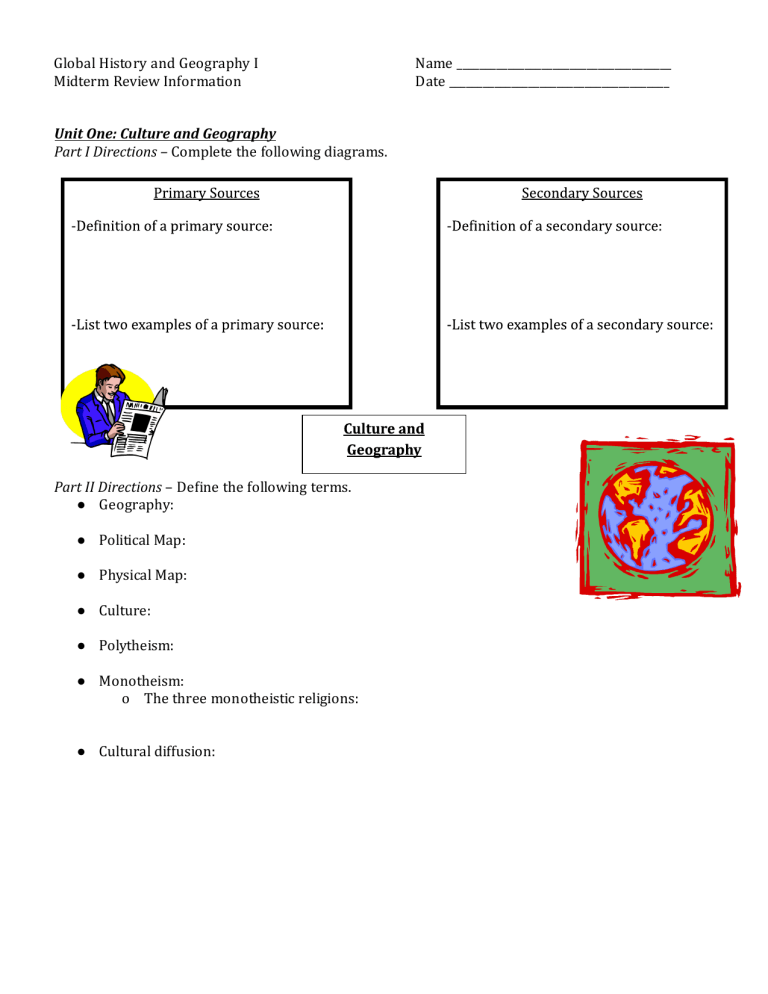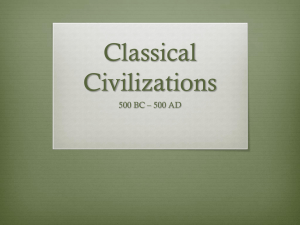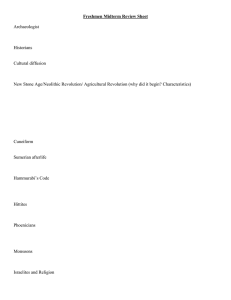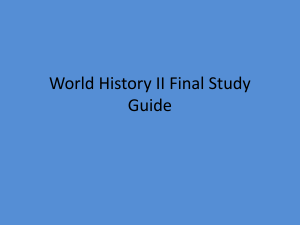
Global History and Geography I Midterm Review Information Unit One: Culture and Geography Part I Directions – Complete the following diagrams. Part II Directions – De ine the following terms. ● Geography: ● Political Map: ● Physical Map: ● Culture: ● Polytheism: ● Monotheism: o The three monotheistic religions: ● Cultural diffusion: Name ______________________________________ Date _______________________________________ Unit Two: Anthropology and the Study of Early Man Part I Directions - De ine the following terms: ⮚ Artifact: ⮚ Archaeologist: ⮚ Anthropologist: ⮚ Economist: Part II Directions – Complete the following t-chart on the Paleolithic and Neolithic Ages. Paleolithic Age (OLD STONE AGE) Neolithic Age (Neolithic Revolution = MAJOR TURNING POINT IN HISTORY!) Part III Directions – Complete the following chart below on features of civilizations: Unit Three: Ancient River Valley Civilizations (Mesopotamia, Egypt, India, and China) Part I Directions – Match the terms with their de initions. River Valley Civilization # 2 = Indus River Part II Directions - Match the terms with their descriptions. Part IV Directions – Complete the missing words in the paragraphs by using the word bank. China was geographically _______________________________, and because of this, they were ___________________________________________. This is the belief that one’s own race or ethnic group is the most important and/or that some or all aspects of its culture are superior to those of other groups. China has mountains, _________________________, and two main rivers, which are the ____________________________________________ River and the _______________________________________ River. A __________________________ is a family of rulers. The irst dynasty in China was the _________________________. The Shang used _____________________________________________ to communicate with the dead. After the Shang Dynasty, the ____________________________ Dynasty gained power. The Zhou believed in the _____________________________________________, which is also known as the dynastic cycle. The Mandate of Heaven is the theory that the ruler was chosen and favored by the supreme deity (god) and would keep the title as long as he served as a wise, principled, and energetic guardian of his people. There were three schools of thought in China. These were: Legalism, Confucianism, and Daoism. Legalists believe that strict laws were required to maintain order. ______________________________________ was a famous Chinese philosopher. He believed in _________________________________________, which is having respect for parents and ancestors. He also believed in the ive relationships. Confucius advocated for the __________________________________________________, which were tests needed to attain government positions. The founder of Daoism was ______________________________. Daoists believe that violence should be avoided and people should embrace nature. Unit Four: Indo-Europeans, Hinduism and Buddhism Part I Directions – Complete the Venn diagram on Hinduism and Buddhism. Part II Directions – Answer the following multiple choice questions. 1.) The Eightfold Path, the Four Noble Truths, and the concept of nirvana are associated with the religion of a. Islam b. Hinduism c. Shinto d. Buddhism 2.) Which values are most closely associated with the fundamental principles of Buddhism? a. Competition b. Maintaining the caste system and providing education for all people c. Practicing nonviolence and giving up worldly desires d. Self-determination and democracy 3.) The terms Brahma, dharma, and karma are all associated with which religion? a. Judaism c. Christianity b. Hinduism d. Animism 4.) Which belief is shared by Hindus and Buddhists? a. Everyone should have the same social status b. People should pray ive times a day c. The soul can escape reincarnation d. Material wealth is a sign of the blessing of the gods 5.) According to Buddhist principles, believers can end personal suffering by a. praying ive times a day b. eliminating sel ish desires c. making pilgrimages to the Ganges River d. relying on divine help 6.) In India, the Caste system determined a person’s occupation, personal associations, and marriage partner. This situation shows that the Caste system a. has helped eliminate ethnic and religious rivalries b. has promoted social mobility within Indian society c. has been stronger in urban areas that in rural areas d. has been a way of life as well as an element of religion 7.) Who is the founder of Buddhism? a. Prince Siddhartha b. King Asoka c. There is no founder. d. Abraham Unit Five: Age of Empires (India’s First Empires, China’s First Empires) Part I Directions – Match the terms with their descriptions. Part II Directions – Answer the following multiple choice questions. 1.) The purpose of the Great Wall was to a. protect the Chinese from the nomadic tribes of northern and central Asia b. supply food from the south to Khanbalik (Beijing) c. control the lood waters of the Huang He and the Chang Jiang rivers d. protect the port city of Guangzhou 2.) The Silk Road was important because it allowed for the a. exploration of China by the Roman Army b. development of agriculture by the nomadic people of central Asia c. movement of Chinese armies through Southeast Asia d. exchange of goods between Asia and the Middle East 3.) Before the use of the Silk Road, how did geography affect early China? a. The mountains and deserts in western and southwestern China slowed the exchange of ideas. b. The northwestern region provided many fertile areas suitable for farming. c. The three major river systems provided barriers against invasion. d. The lack of deep-water ports on the eastern coast prevented China from developing trade with other nations. 4.) The rule of Shi Huangdi, legalism, and the tomb of terracotta soldiers are most closely associated with the a. Maurya Empire b. Qin Dynasty c. Persian Empire d. Hellenistic culture 5.) Read the following bullet points and decide what the title of the list should be. a. b. c. d. Pax Sinica during the Qin Dynasty Pax Sincia during the Han Dynasty Confucianism Accomplishments of Shi Huangdi Unit Six: Classical Civilizations (Greece and Rome) and Christianity Part I Directions – Explain how Greece’s geography in luenced civilization. Part II Directions – Complete the following charts on Athens and Sparta by writing at least three facts about each city state. Part III Directions – List Greek achievements (consider achievements in math, philosophy, science, medicine, literature, athletics, art, architecture, and government). Part IV Directions – Answer the following question by referring to the visual. Part IV Directions – Answer the following multiple choice questions. 1.) A major contribution of the Roman Republic to Western European culture was the a. concept of government by laws b. rejection of the concept of slavery c. belief that political power should be controlled by the military d. establishment of agricultural communes 2.) How did the geography of the Italian peninsula in luence the development of the Roman Empire? a. The unnavigable rivers in the northern part of the peninsula protected the Romans from their neighbors. b. The location of the peninsula contributed to Roman control of the Mediterranean region. c. The harsh climate prevented agricultural production on the Italian peninsula. d. The length and rugged seacoast encouraged frequent invasions of the Italian peninsula. 3.) One contribution of ancient Roman culture was the development of a. the concept of zero b. the process of making silk c. a republican form of government d. the printing press 4.) Which characteristic is shared by the ancient Roman Republic and the United States? a. Economic prosperity continued only as long as each society continued to expand its boundaries. b. Both societies were able to avoid periods of civil strife. c. Desire for religious freedom was a major factor in uniting the people into a single nation. d. Both societies established a form of representative government. 5.) China under the Han dynasty and the Roman Empire were similar in that both grew wealthy because they a. developed extensive trade networks b. created classless societies c. encouraged democratic ideals d. established free-market economies 6.) After the western Roman Empire fell to Germanic invaders in the 5th century A.D., the eastern part of the empire eventually became known as the a. Persian Empire b. Islamic Empire c. Mongol Empire d. Byzantine Empire Part V Directions – Complete the following web on Christianity. Unit Eight: The Muslim World Part I Directions – Complete the following web. 1.) Read the following bullet points and then answer the question. ● Islamic scholars made signi icant contributions to astronomy. ● Muslim architects excelled in design. ● Schools and libraries were built in Islamic urban centers. Which conclusion about Islamic society during its Golden Age can best be supported by these statements? a. Social status of Muslims was determined at birth. b. Achievements relied on a knowledge of math and science. c. People of diverse faiths were required to convert to Islam. d. Cities developed self-suf icient economies. 2.) Judaism, Christianity, and Islam share a belief in a. reincarnation c. teachings of the Quran (Koran) b. many gods d. one god 3.) __________________________________ is the ninth month of the Muslim calendar in which Muslims must fast during daylight hours. a. Hajj c. Hijrah c. Ramadan d. Jihad




